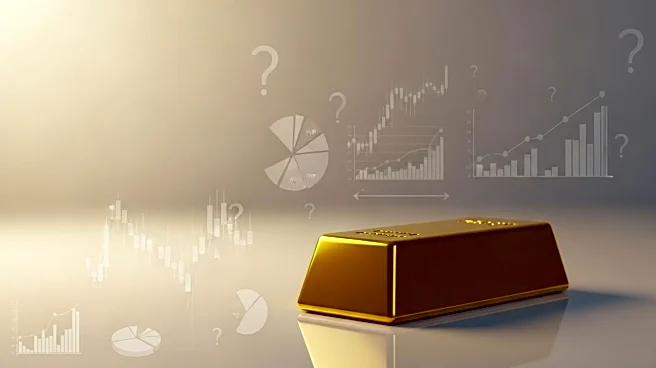What is the story about?
What's Happening?
Gold prices have reached new all-time highs in early October 2025, surpassing $4,000 per ounce as investors seek safe-haven assets amidst global uncertainty. The surge in gold prices is attributed to several factors, including expectations of lower U.S. interest rates, geopolitical tensions, and a weaker U.S. dollar. The 10-year Treasury yield has decreased, reducing the opportunity cost of holding gold, which is a non-yielding asset. The U.S. Federal Reserve's recent interest rate cut and anticipated further cuts have fueled investor demand for gold. Additionally, the ongoing U.S. government shutdown and comments from President Trump regarding potential tariffs on China have increased market volatility, further driving gold demand.
Why It's Important?
The rise in gold prices reflects broader economic and geopolitical uncertainties impacting global markets. As a traditional safe-haven asset, gold's increased demand indicates investor concerns over potential economic instability and policy risks. The decline in U.S. Treasury yields suggests a shift in investor sentiment towards safer investments, which could have implications for the broader financial markets. The situation highlights the interconnectedness of global economic policies and their impact on commodity prices. Investors and policymakers will need to monitor these developments closely, as they could influence future economic strategies and market dynamics.
What's Next?
Looking ahead, gold prices are expected to remain strong, supported by ongoing geopolitical tensions and potential further interest rate cuts by the U.S. Federal Reserve. Key economic data releases and central bank meetings will be closely watched for indications of future policy directions. The U.S.-China trade relations and the resolution of the government shutdown are critical factors that could influence market sentiment and gold prices. Analysts predict continued upside potential for gold, barring any unexpected policy shifts or significant changes in market conditions.
Beyond the Headlines
The surge in gold prices also underscores the role of central banks in shaping global economic trends. With central banks, particularly in China, continuing to add gold to their reserves, the metal's status as a hedge against currency and economic risks is reinforced. This trend may lead to long-term shifts in reserve management strategies and influence global financial stability. Additionally, the increased demand for gold-backed ETFs highlights the growing importance of gold as a portfolio diversifier for institutional and retail investors.
AI Generated Content
Do you find this article useful?













